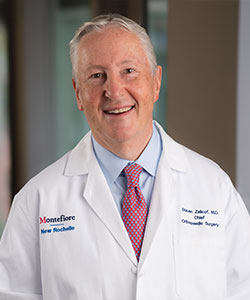Partial Knee Replacement in Westchester County, NY

What is partial knee replacement surgery?
Partial knee replacement is a surgical treatment option that replaces (or resurfaces) only the damaged portion of the knee while conserving knee ligaments and unaffected cartilage.
Patients with unicompartmental knee arthritis have cartilage degeneration in only one section or compartment of the knee. In cases where nonsurgical techniques do not provide sufficient symptom relief, our Harrison orthopedic surgeons can remove damaged cartilage and bone in the diseased area only, while preserving the ligaments that help support the knee joint.
A prosthesis, also called an implant, takes the place of the damaged area of the knee, leaving the other compartments intact.
Partial knee replacement surgery may also be referred to as partial knee resurfacing, unicondylar knee surgery, unicondylar knee replacement, or unicondylar knee arthroplasty.
What are the benefits of having partial knee replacement surgery?
The advantages of choosing to undergo partial knee replacement with one of our qualified surgeons at Specialty Orthopaedics include the following:
- Proven outcomes and metrics – Dr. Zelicof has been recognized by New York Magazine, Westchester Magazine and Castle Connolly Top Doctors in America for over 25 years
- Our Joint Solutions program was the first in Westchester to be recognized and reaccredited three times by the Joint Commission with Gold Seals in Hip and Knee Replacement
- Access to experienced and caring fellowship-trained, university-affiliated surgeons
- A commitment to evidence-based orthopedic techniques, advanced minimally invasive approaches and pain management techniques
- Surgery performed at some of the best orthopedic hospitals in the country
- When considering joint replacement surgery, trust your knee to someone who treats other physicians and healthcare professionals
Am I a Candidate for Partial Knee Resurfacing?
Partial knee replacement is appropriate for patients with arthritis that is confined to a single compartment of the knee and is generally restricted to patients who are not morbidly obese. The surgery is not appropriate for patients with marked stiffness in the knee or those with a significant angular deformity. Intact ligaments are generally a requirement for a partial knee replacement. Patients with rheumatoid arthritis are not candidates for partial knee solutions since inflammatory-type arthritis typically involves the entire joint.
Additional considerations are evaluated on a case-by-case basis with the surgeon and patient determining together whether partial knee replacement is the best treatment option. Selecting the right patient is considered one of the most important steps to ensuring a good functional outcome and longevity for a partial knee replacement.
How is Partial Knee Surgery Performed at Specialty Orthopaedics?
During partial knee replacement, the orthopedic surgeon makes a small incision to gain access to the affected compartment of the knee. He or she gently moves supporting structures of the knee out of the way and removes damaged cartilage and bone tissue from the surfaces of the tibia and the femur in the arthritic area. This procedure is performed using pre-operative CT scanning with 3-D templating and using robotic-assisted technology. The surgeon then prepares these surfaces using a Mako robotically-assisted burr for insertion of the prosthesis components which are specifically sized to the patient’s joint. Cement is used to secure these components. All surrounding structures and tissues are restored to their anatomic position and the incision is closed.
Patients who have been properly screened for the procedure can expect to experience a low level of complications and a rapid recovery. However, as with other types of knee surgery, in a small percentage of cases, revision surgeries are required. Results obtained with revision surgery may not be as good as those achieved with primary surgery.
What is the Recovery from Partial Knee Replacement Surgery?
Following surgery, most patients undergoing partial knee replacement can expect to spend one to two nights in the hospital. Most patients are able to walk with assistance, or independently, on the same day as their surgery. Typically, the patient is given a cane within a week of surgery to allow for increased independence and begins outpatient rehabilitation. Patients are often finished taking narcotic-type pain medication within four weeks post-surgery.
Partial knee replacement usually involves minimal blood loss and is associated with a low rate of complications; most patients can expect to be back to their daily activities within three to six weeks. Many patients find that after undergoing physical rehabilitation, they are able to return to sports such as golf, within six to ten weeks.
VIDEO GALLERY: Partial Knee Replacement Animations
Please explore our partial knee replacement videos below. Use the left and right arrows to scroll between the various videos in this library.
If you are interested in partial knee replacement, visit Specialty Orthopaedics. Our New York orthopedic practice is home to a team of fellowship-trained orthopedists in a variety of specialty areas. We offer comprehensive treatment for musculoskeletal disorders in a caring and responsive clinical atmosphere. Give us a call at 914.686.0111 or fill out the form on this page to schedule your appointment today.
Frequently Asked Questions About Partial Knee Replacement
Yes. Partial knee replacement, partial knee resurfacing surgery, unicompartmental knee replacement, and unicondylar knee replacement all refer to the same procedure.
There are no strict recommendations, but in general, partial knee replacements are appropriate for patients over 40 years old who meet other eligibility criteria.
Knee prostheses or implants are made of metal and plastic. These surfaces are designed to glide smoothly against one another just as cartilage does in a healthy knee.
Although not all patients are able to return to unrestricted sport, many patients are able to resume biking, tennis and skiing.
As with any joint replacement surgery, complications may include instability of the knee, loosening of the implant, infection, nerve injury and deep vein thrombosis. Generally, complications occur less frequently after partial knee replacement than they do following total knee replacement. Be sure to discuss any concerns you have regarding these or other issues with your surgeon.
All surgeries result in some pain. We have resources dedicated to address post-operative pain management. While pain varies by patient, typically patients experience less pain and stiffness following partial knee replacement than they do after total knee replacement. After partial knee replacement surgery, most patients receive 7-14 days of narcotic medications.
Partial knee replacement will address the arthritis that is present in the particular compartment of the knee that is affected. However, there is no guarantee that arthritis will not develop elsewhere in the knee. Should this occur, surgical revision may be necessary.
A well-done partial knee replacement in an appropriately selected patient can have a survival rate that is comparable to that achieved with a total knee replacement in the first decade following surgery. The literature suggests that after the second decade, the revision rate may be somewhat higher for partial knee surgery than for total knee surgery.









